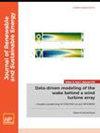屏障和可变间距可增强太阳能光伏发电厂的对流冷却并提高发电量
IF 1.9
4区 工程技术
Q4 ENERGY & FUELS
引用次数: 0
摘要
当太阳能光伏(PV)组件的温度升高时,效率就会下降,组件的老化速度也会加快。因此,降低组件的工作温度是有益的。在传热和植物冠层流领域,先前的研究表明,系统级布置修改(如可变间距、屏障或挡风板)可以被动地改变流向、增强湍流混合并影响对流。然而,研究人员尚未探索可变间距或屏障如何增强太阳能发电厂的对流冷却。在此,我们通过高分辨率大涡流模拟,模拟了太阳能发电厂中通过缺失模块和隔离墙的气流和热传递情况。然后,我们进行了控制体积分析,以评估净热流量并计算 h,从而量化这些空间改造对对流冷却的影响,进而影响组件温度和功率输出。安装隔离墙的改善效果最大,h 增加了 3.4%,模块温度降低了约 2.5 °C,功率输出平均提高了约 1.4%。这些研究结果表明,在光伏电站设计中加入可变间距或屏障型元件可以降低组件温度,从而提高光伏性能和使用寿命。本文章由计算机程序翻译,如有差异,请以英文原文为准。
Barriers and variable spacing enhance convective cooling and increase power output in solar PV plants
When the temperature of solar photovoltaic (PV) modules rises, efficiency drops and module degradation accelerates. Thus, it is beneficial to reduce module operating temperatures. Previous studies of solar power plants have illustrated that incoming flow characteristics, turbulent mixing, and array geometry can strongly impact convective cooling, as measured by the convective heat transfer coefficient h. In the fields of heat transfer and plant canopy flow, previous work has shown that system-scale arrangement modifications—e.g., variable spacing, barriers, or windbreaks—can passively alter the flow, enhance turbulent mixing, and influence convection. However, researchers have not yet explored how variable spacing or barriers might enhance convective cooling in solar power plants. Here, high-resolution large-eddy simulations model the air flow and heat transfer through solar power plant arrangements modified with missing modules and barrier walls. We then perform a control volume analysis to evaluate the net heat flux and compute h, which quantifies the influence of these spatial modifications on convective cooling and, thus, module temperature and power output. Installing barrier walls yields the greatest improvements, increasing h by 3.4%, reducing module temperature by an estimated 2.5 °C, and boosting power output by an estimated 1.4% on average. These findings indicate that incorporating variable spacing or barrier-type elements into PV plant designs can reduce module temperature and, thus, improve PV performance and service life.
求助全文
通过发布文献求助,成功后即可免费获取论文全文。
去求助
来源期刊

Journal of Renewable and Sustainable Energy
ENERGY & FUELS-ENERGY & FUELS
CiteScore
4.30
自引率
12.00%
发文量
122
审稿时长
4.2 months
期刊介绍:
The Journal of Renewable and Sustainable Energy (JRSE) is an interdisciplinary, peer-reviewed journal covering all areas of renewable and sustainable energy relevant to the physical science and engineering communities. The interdisciplinary approach of the publication ensures that the editors draw from researchers worldwide in a diverse range of fields.
Topics covered include:
Renewable energy economics and policy
Renewable energy resource assessment
Solar energy: photovoltaics, solar thermal energy, solar energy for fuels
Wind energy: wind farms, rotors and blades, on- and offshore wind conditions, aerodynamics, fluid dynamics
Bioenergy: biofuels, biomass conversion, artificial photosynthesis
Distributed energy generation: rooftop PV, distributed fuel cells, distributed wind, micro-hydrogen power generation
Power distribution & systems modeling: power electronics and controls, smart grid
Energy efficient buildings: smart windows, PV, wind, power management
Energy conversion: flexoelectric, piezoelectric, thermoelectric, other technologies
Energy storage: batteries, supercapacitors, hydrogen storage, other fuels
Fuel cells: proton exchange membrane cells, solid oxide cells, hybrid fuel cells, other
Marine and hydroelectric energy: dams, tides, waves, other
Transportation: alternative vehicle technologies, plug-in technologies, other
Geothermal energy
 求助内容:
求助内容: 应助结果提醒方式:
应助结果提醒方式:


